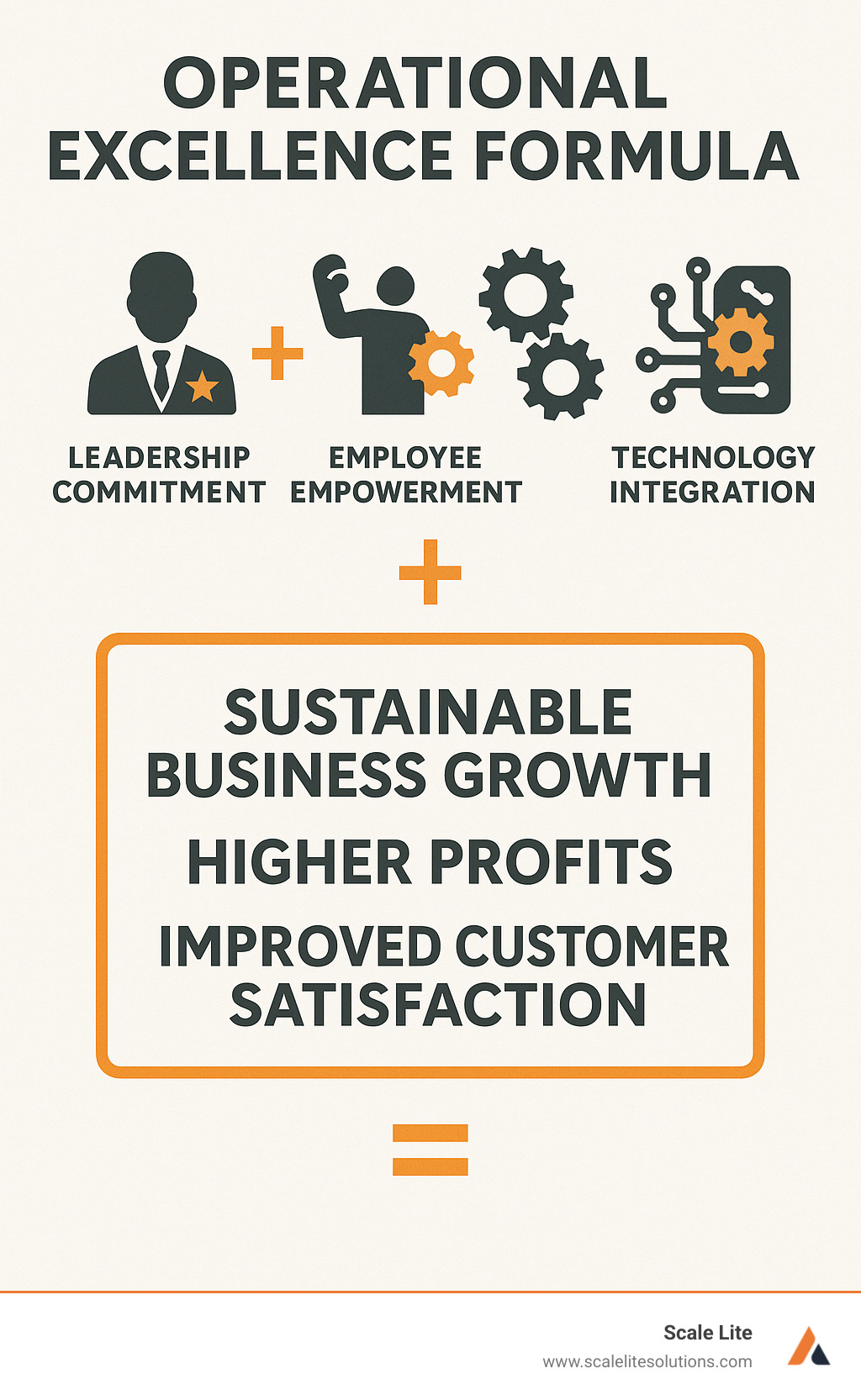
The Future of Operational Excellence (Hint: It's Easier Than You Think)

Why Operational Excellence Strategies Transform Blue-Collar Businesses
Operational excellence strategies are systematic approaches to improving how your business delivers value to customers while eliminating waste and empowering employees. Here are the core strategies that drive results:
Key Operational Excellence Strategies:
- Lean principles - Eliminate waste and create smooth workflow
- Continuous improvement (Kaizen) - Make small, consistent improvements daily
- Process standardization - Document and optimize how work gets done
- Data-driven decision making - Use metrics to guide improvements
- Employee empowerment - Give frontline workers authority to solve problems
- Customer focus - Align all activities to deliver maximum customer value
- Technology integration - Use automation to reduce manual work and errors
The impact is significant. Organizations that follow operational excellence strategies report profits 2.5 times higher than those that don't, according to research from BTOES. But here's the surprising truth: you don't need massive budgets or complex systems to get started.
Most blue-collar business owners think operational excellence is only for Fortune 500 companies. That's wrong. The principles work just as well for a 10-person plumbing company as they do for a global manufacturer. The difference is in how you apply them.
I'm Keaton Kay, and I've spent years helping service businesses implement operational excellence strategies through my work in private equity, enterprise sales, and revenue operations. At Scale Lite, I focus specifically on helping blue-collar business owners modernize their operations without the corporate complexity.

What is Operational Excellence (And Why Does It Matter)?
Think of operational excellence as the difference between a chaotic job site where everyone's scrambling to find tools and a smooth operation where every team member knows exactly what to do, when to do it, and how to make it better. It's not about reaching some perfect finish line – it's about building a culture where everyone constantly looks for ways to deliver more value to customers.
Dr. Joseph Juran, a pioneer in quality management who helped transform how businesses think about quality, described operational excellence as a holistic approach to improving performance and delivering value to customers. What made Dr. Juran's insights so powerful was his understanding that excellence isn't just about fixing problems – it's about creating systems where problems rarely happen in the first place.
Operational excellence strategies work because they shift your entire organization from reactive firefighting to proactive value creation. Instead of just getting work done, everyone starts asking: "How can we do this better for our customers?" It's the mindset that turns good businesses into great ones.
This approach combines three essential elements: empowered people who understand their role in creating value, optimized processes that eliminate waste and bottlenecks, and smart technology that supports rather than complicates the work. When these pieces work together, something remarkable happens – your business becomes both more profitable and more enjoyable to run.
The Real-World Impact on Your Business
The results speak for themselves. Companies using operational excellence strategies don't just perform slightly better – they dramatically outperform their competition. Here's what that looks like in practice:
Increased profits become almost inevitable when you eliminate waste and optimize processes. 2.5 times higher profit figure? That's not from working harder – it's from working smarter and empowering your team to spot improvements every day.
Higher productivity naturally follows when people aren't fighting broken processes or hunting for information. When your field technicians can access job details instantly, when your scheduling system prevents double-bookings, and when your inventory management keeps the right parts in stock – suddenly everyone gets more done without the stress.
Better customer satisfaction happens because operational excellence puts the customer at the center of everything. When your processes are designed around delivering value rather than just completing tasks, customers notice. They get faster service, more consistent quality, and fewer surprises on their bills.
Improved employee engagement might be the most surprising benefit. When people understand how their work creates value and have the authority to make improvements, they stop feeling like cogs in a machine. They become problem-solvers and innovators. This leads to lower turnover, better teamwork, and employees who actually care about the business's success.
Improved business resilience gives you the flexibility to handle whatever challenges come your way. Companies with strong operational foundations adapted much better during recent disruptions because they had systems, processes, and engaged teams that could pivot quickly.
The key difference between operational excellence and related concepts often confuses business owners, so let's clear that up:
| Feature | Operational Efficiency | Process Excellence | Operational Excellence |
|---|---|---|---|
| Primary Focus | Doing things right (cutting costs, saving time) | Perfecting one specific process | Doing the right things, right (creating lasting value) |
| Scope | Individual tasks or departments | Single process from start to finish | Entire organization working together |
| Goal | Maximum output, minimum input | Streamline and standardize workflows | Sustainable growth through customer value |
| Culture Aspect | Task-focused individual performance | Process-focused workflow improvement | Culture of continuous improvement and empowerment |
Operational efficiency focuses on using resources wisely – important, but limited. Process excellence perfects individual workflows – valuable, but narrow. Operational excellence creates an organization where everyone contributes to customer value, not just cost-cutting.
It's the difference between having a few efficient workers and having an entire company that consistently delivers exceptional results. You can explore more about how these principles transform service businesses on our Improve Business Operations resource page.
The Core Methodologies Simplified
When we talk about operational excellence strategies, we often hear terms like Lean, Six Sigma, and Kaizen thrown around. These aren't just corporate buzzwords designed to confuse you; they're proven methodologies that have transformed businesses just like yours. The good news? You don't need an MBA to understand or use them.
Think of these methodologies as different tools in your toolbox. Each one serves a specific purpose, but they all work together to help you build something better. Let's break them down into simple, practical concepts that you can actually use.

Lean: Maximizing Value by Minimizing Waste
Imagine watching one of your best technicians spend 30 minutes every morning hunting for the right tools, driving back to the shop for forgotten parts, or sitting in traffic because they took the long route. Frustrating, right? That's exactly what Lean methodology helps you eliminate.
Lean thinking is all about identifying and eliminating waste so you can maximize the value you deliver to your customers. It's like streamlining a delivery route—you want to get from point A to point B as efficiently as possible, without unnecessary detours.
The beauty of Lean lies in its five core principles. Value means understanding what your customer actually cares about. For a plumbing company, it's not just fixing a leak—it's fixing it quickly, cleanly, and permanently without turning their home into a construction zone. Value stream involves mapping out every single step from when a customer calls to when you shake hands goodbye, identifying what adds value and what doesn't.
Flow ensures work moves smoothly through your processes without bottlenecks or delays. Think of a river flowing steadily downstream versus water getting stuck in stagnant pools. Pull means only doing work when there's actual customer demand, avoiding the waste of overproduction. Finally, perfection is the ongoing pursuit of eliminating all forms of waste.
This approach aligns perfectly with the goal of developing systems to streamline processes, ensuring every step in your operation contributes directly to customer value.
Kaizen: Small Changes, Big Results
While Lean gives you the big picture, Kaizen is your daily practice of getting a little bit better. The Japanese word "Kaizen" means continuous improvement, and it's built on a simple idea: small, consistent changes add up to remarkable results over time.
Think of Kaizen like saving money—putting away just $5 a day doesn't seem like much, but after a year, you've got nearly $2,000. Similarly, small improvements in your daily operations can lead to massive gains. Maybe it's reorganizing your truck so tools are easier to find, or creating a simple checklist that prevents callbacks.
The magic of Kaizen happens when you create a culture where everyone looks for ways to make things better. Your frontline employees often have the best insights into what's working and what isn't—they're the ones dealing with the real-world challenges every day. When you encourage employees to identify areas for improvement, you tap into a goldmine of practical solutions.
The best part? Kaizen doesn't require big budgets or dramatic overhauls. It's about empowering your team to make incremental improvements that compound over time.
Six Sigma: A Data-Driven Approach to Quality
If Lean is about speed and Kaizen is about continuous small steps, Six Sigma is about precision and consistency. This methodology focuses on reducing variation and eliminating defects to ensure you deliver quality results every single time.
Six Sigma was developed by Bill Smith at Motorola in the 1980s, and it uses a structured approach called DMAIC. Don't worry—it's simpler than it sounds. Define means clearly identifying what problem you're trying to solve. Measure involves collecting data on how things currently work. Analyze means digging into that data to understand why problems happen. Improve is about implementing solutions, and Control ensures those improvements stick.
Here's a real-world example: Let's say you're getting too many customer complaints about technicians arriving late. Instead of just telling everyone to "be on time," Six Sigma would have you measure exactly how often appointments run late, analyze the root causes (traffic, previous jobs running over, poor scheduling), implement specific solutions, and then track the results to make sure the problem stays solved.
This data-driven approach is fundamental to modern business success, which is why we emphasize its importance through our focus on Data-Driven Decision Making at Scale Lite Solutions.
The Shingo Model provides another comprehensive framework, emphasizing principles like respecting every individual, leading with humility, and focusing on process improvement. These principles remind us that operational excellence strategies aren't just about tools and techniques—they're about creating a culture where everyone is committed to delivering value and continuously improving.
A Practical Blueprint: Your Key Operational Excellence Strategies
Now that we understand the core methodologies, let's look at a practical blueprint for implementing operational excellence strategies in your business. This isn't just theory; it's a roadmap we use to help our clients achieve sustainable growth.

Implementing operational excellence is a journey, not a sprint. It requires commitment from everyone, from the top leadership to the frontline team. It's about aligning your strategic goals with your daily operations and ensuring clear, consistent communication throughout the process. For a comprehensive guide on how we help businesses achieve this, explore our page on How to Achieve Operational Excellence.
Step 1: Build a Culture of Excellence
Operational excellence starts and ends with people. You can have the best processes and technology in the world, but without the right culture, your efforts will fall flat. A culture of excellence means:
- Leadership Role: Leaders must not just oversee; they must own and actively participate in the continuous improvement journey. This means demonstrating humility, being open to feedback, and leading by example. Senior executives receiving coaching on developing an open problem-solving environment, as seen in some successful companies, is a great example of this.
- Employee Empowerment: Your frontline employees are your eyes and ears on the ground. They often know best where inefficiencies lie and how to fix them. Empower them to identify problems, suggest solutions, and even implement changes. Organizations that prioritize employee engagement typically have lower turnover rates and higher levels of customer satisfaction. This requires commitment from everyone in the organization, as highlighted in discussions by G2.
- Psychological Safety: Create an environment where employees feel safe to speak up, share ideas, and even make mistakes without fear of blame. Focus on the "process" when something goes wrong, rather than blaming the "person." This encourages experimentation and learning.
- Open Feedback Channels: Ensure there are clear, accessible ways for employees to provide feedback, ask questions, and contribute ideas. Provide training opportunities to help your team develop the skills needed for this new way of working.
Step 2: Map Your Processes and Leverage Technology
You can't improve what you don't understand. Process mapping is like drawing a detailed map of your daily operations. It helps you visualize every step, identify bottlenecks, and pinpoint areas for improvement.
- Process Mapping: Start by mapping out your key processes, such as customer onboarding, service delivery, or invoicing. Use simple flowcharts or diagrams. This will reveal inefficiencies that might have been invisible before. For instance, documenting how a hospital doctor refers a patient for an X-ray can reveal potential delays and help streamline the process. You can learn more about how we help with Business Process Streamlining.
- Automation Opportunities: Once you've mapped your processes, look for repetitive, rule-based tasks that can be automated. This is where technology becomes your greatest ally. For example, automating data entry, scheduling, or even basic customer responses can free up your team to focus on higher-value work. We leverage AI-Driven Workflow Automation to help our clients achieve this. Many technological innovations have failed to accelerate productivity as expected when simply grafted onto existing operations. Technology should augment human capabilities, not simply replace humans with machines.
- Real-World Example: Consider a large energy company's long-term commitment to operational excellence. By focusing on safety, reliability, and efficiency through systematic process improvements and strategic technology adoption, they have set a benchmark for their industry. This commitment involves continuously refining technical systems to eliminate waste and leveraging technology to improve operational processes, ensuring that every aspect of their operations contributes to overall value delivery. This exemplifies industry best practices in operational excellence, demonstrating how sustained effort and strategic technology integration drive significant results.
Step 3: Measure What Matters and Drive Improvement
"What gets measured gets managed." To truly achieve operational excellence, you need to define clear metrics, track your progress, and use data to make informed decisions.
- Key Performance Indicators (KPIs): Identify the most critical metrics for your business. These could include customer satisfaction scores, service completion times, error rates, or employee engagement levels. Make sure your KPIs are SMART (Specific, Measurable, Achievable, Relevant, and Time-bound). For more on this, see Identifying and tracking your KPIs.
- Visual Management: Make your KPIs and progress visible to the entire team. Use dashboards, charts, or simple whiteboards. This creates transparency and keeps everyone motivated.
- Performance Tracking: Regularly review your performance against your KPIs. If something isn't working, use root cause analysis (like the 5 Whys or fishbone diagrams) to understand why. For example, if freelancers complain about slow payments from a media company, root cause analysis might reveal bottlenecks in the invoicing process.
- Continuous Improvement Cycle: Accept the Plan-Do-Check-Act (PDCA) cycle. Plan your improvement, implement it, check the results, and then act to standardize or refine. This ensures that improvement is an ongoing process.
By systematically implementing these steps, you'll be well on your way to achieving operational excellence and changing your business. We help our clients achieve this by focusing on How to Improve Business Performance.
Frequently Asked Questions about Operational Excellence
Running a service business means dealing with practical questions every day. When it comes to operational excellence strategies, we hear the same concerns from business owners across different industries. Let's address the most common ones with straight answers.
What's the difference between operational excellence and continuous improvement?
Think of operational excellence as building your dream house, while continuous improvement is the daily maintenance that keeps it in perfect condition.
Operational excellence is your big-picture strategy—the complete cultural change that touches every corner of your business. It's about creating an organization where everyone understands how their work creates value for customers and feels empowered to make it better. This encompasses your leadership approach, company culture, technology choices, and overall business philosophy.
Continuous improvement, on the other hand, is one of the key tools you use to achieve operational excellence. It's the daily practice of making small, incremental changes—like finding a faster way to complete paperwork or reorganizing your truck for quicker job setup. These small improvements add up to significant results over time.
Here's a simple way to think about it: if operational excellence is your destination, then continuous improvement is the fuel that gets you there. It's widely understood that continuous improvement is a key component of the broader operational excellence strategy, not a separate concept competing with it.
What are the biggest challenges to achieving operational excellence?
Every business owner we work with faces similar problems when implementing operational excellence strategies. The good news? These challenges are completely normal and absolutely solvable.
Resistance to change tops the list. Your team members might worry that new processes mean more work or threaten their job security. Sometimes leadership hesitates because they're comfortable with "the way we've always done things." This resistance often comes from fear of the unknown rather than actual problems with improvement.
Lack of clear goals creates another major stumbling block. Without specific targets and measurable outcomes, your improvement efforts can feel like throwing darts in the dark. Teams lose motivation when they can't see progress or understand why changes matter.
Insufficient resources frequently derails good intentions. Operational excellence requires investment in training, time, and sometimes technology. Many businesses start strong but struggle to maintain momentum when daily pressures take priority.
Siloed departments create invisible barriers to success. When your office staff, field technicians, and management operate in separate worlds, communication breaks down. Cross-functional improvements become nearly impossible.
The solution? Start with clear communication about why these changes benefit everyone. Get leadership buy-in from day one—senior leaders must champion the effort and allocate necessary resources. Begin small with one process improvement that delivers quick wins, then build momentum from there. Most importantly, celebrate successes along the way to keep your team motivated.
How can a small service business apply these big concepts?
This question gets to the heart of what we do at Scale Lite Solutions. The beauty of operational excellence strategies lies in their scalability—you don't need Fortune 500 resources to see Fortune 500 results.
Focus on principles rather than complex methodologies. Instead of implementing a full Six Sigma program, simply commit to reducing errors in your most critical processes. Rather than overhauling everything with Lean principles, start by identifying and eliminating obvious waste in your daily operations.
Choose one high-impact process as your starting point. Maybe it's how you handle customer calls, schedule appointments, or complete job paperwork. Map out every step, find the bottlenecks, and make small improvements. Once you see results, expand to the next process.
Empower your frontline team to identify improvements. Your technicians and field staff see inefficiencies that office management might miss. Create simple ways for them to share ideas and implement small changes. A plumber who suggests reorganizing the truck layout or an electrician who finds a faster way to complete safety checks can save hours every week.
Use simple, affordable technology to support your improvements. You don't need expensive enterprise software—basic workflow automation, digital forms, and simple tracking tools can transform your operations. We help businesses leverage technology appropriately, from CRM optimization to AI deployment that actually makes sense for service companies.
The key is remembering that operational excellence isn't about perfection—it's about progress. Small service businesses often have advantages over larger companies because they can implement changes quickly and see results immediately. For practical guidance on how small businesses can leverage these concepts effectively, explore our insights on Digital Change Strategies for Small Businesses at https://scalelitesolutions.com/resources/digital-change-strategies-for-small-businesses.
Conclusion
We've taken quite a journey together exploring operational excellence strategies, and I hope you can see just how transformative they can be for your business. From the impressive 2.5 times higher profits to the boost in productivity, customer satisfaction, and employee engagement – these aren't just nice-to-have improvements. They're game-changers that can fundamentally transform how your organization delivers value.

Here's what I want you to remember: operational excellence is an accessible journey, not some exclusive club for Fortune 500 companies. Whether you're running a plumbing business with five employees or managing a landscaping company with fifty, these principles work. They scale up and down beautifully.
At its core, this is fundamentally a people-centric approach. Your employees – from the newest hire to your most experienced technician – are the real drivers of operational excellence. They're the ones who spot the inefficiencies, suggest the improvements, and make the daily choices that either move you forward or hold you back. When you empower them to think like owners and give them the tools to succeed, amazing things happen.
Technology acts as a powerful enabler in this process, but it's not the star of the show. Think of technology like a really good toolbox – it makes the work easier, faster, and more precise, but you still need skilled people to use those tools effectively. Whether it's workflow automation that eliminates tedious paperwork or data analytics that help you spot trends, technology amplifies your team's capabilities rather than replacing them.
The beauty of embracing these principles is the long-term value they create. Small blue-collar service businesses that commit to operational excellence don't just survive – they thrive. They outperform competitors who are still doing things the old way, and they build resilient operations that can weather any storm.
At Scale Lite Solutions, we've made it our mission to help service businesses implement these strategies to build more valuable and scalable operations. We believe operational excellence shouldn't be complicated or overwhelming. It should be practical, achievable, and custom to your unique business needs.
Ready to transform your business and open up its full potential? Learn how to build Scalable Service Operations with us. Your future self – and your customers – will thank you for taking this step.






